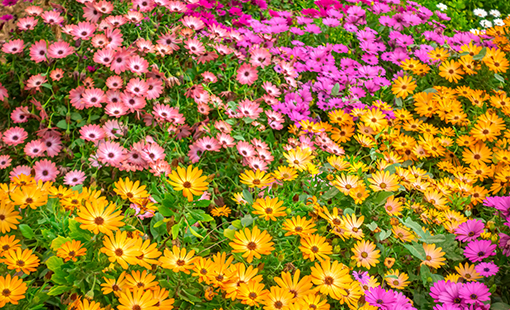
Caring for Cape Daisies
African Cape daisies work equally well in the ground or in containers. Blooms peak in late spring to early summer and again in late summer to early fall. Because Cape daisies stop blooming during hot spells, they are best grown in combination with other plants that will have visual interest in the peak of summer.
These flowers are fairly low-maintenance when grown in an environment they like. Make sure they have lots of sun and soil with good drainage. Plan to water and fertilize regularly throughout the growing season (spring to fall). Also, deadhead the plants (remove the spent blooms) to encourage reblooming.
Light
Cape daisies bloom best in full sun. They can tolerate partial shade, but this will likely cause them to produce fewer flowers. Moreover, the blooms generally open in response to light and close at night and during overcast weather.
Soil
Cape daisies prefer organically rich soil with sharp drainage and a slightly acidic soil pH. Add compost or other organic matter to the soil at the time of planting to improve drainage and add nutrients.
Water
Although somewhat drought tolerant once established, Cape daisies still need at least 1 inch of water per week to grow their best. During periods of drought or intense heat, the plants will slow down and go dormant. Aim to keep the soil evenly moist. But don’t overwater, as soggy soil can encourage diseases such as root rot.
Temperature & Humidity
Cape daisies prefer mild weather, which is when they bloom most profusely. They can handle nighttime temperatures down to about 40 degrees Fahrenheit, though frost can damage or kill them. Humidity typically isn’t an issue for them, as long as they have good air circulation and proper watering and soil drainage.
Fertilizer
These flowers like a lot of food to grow and bloom at their best. Besides mixing compost into the soil, apply a fertilizer for flowering plants monthly throughout the growing season.
Propagating African Daisies
The majority of Cape daisy varieties are hybrids and won’t grow from seeds saved from the plants. But you can easily propagate your plants by cuttings.
To do so, first fill a shallow tray with a sterile seed-starting mixture. Dampen the mix slightly. Then, take plant cuttings 2 to 3 inches long that have at least two sets of leaf nodes. Pinch off any flower buds that are present, and remove the lower leaves. Dip the cut end in rooting hormone, and then plant the cut end in the seed-starting mix. Cover the tray with a plastic dome, and place it in a location with bright indirect light and temperatures between 60 and 68 degrees Fahrenheit. In four to six weeks, the plants should be sufficiently rooted to transplant to pots or to an outdoor garden location.
Common Pests & Diseases
There aren’t many pests or diseases that attack Cape daisies if the plants are kept stress-free in the proper environment. However, in damp or humid conditions be on the lookout for fungal diseases, such as gray mold. Such diseases will present with damaged or discolored foliage. Try to improve the air circulation around your plant, which can combat fungal diseases and use a fungicide if necessary. Moreover, some common plant pests, including whiteflies and aphids, can become a problem, especially for stressed plants. But they can be controlled with an insecticidal soap or chemical spray if caught early.
Information courtesy of TheSpruce.com

 Adams Fairacre Farms
Adams Fairacre Farms